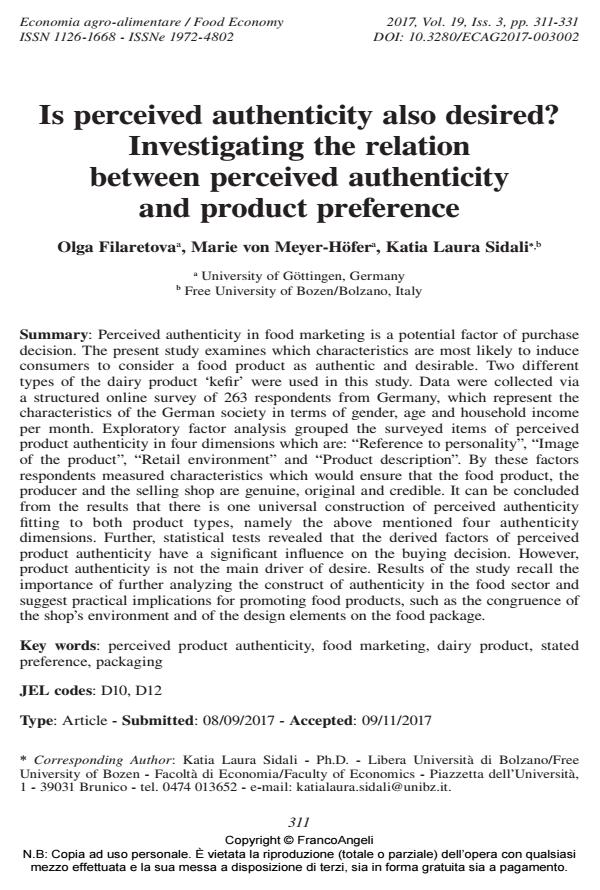Is perceived authenticity also desired? Investigating the relation between perceived authenticity and product preference
Journal title ECONOMIA AGRO-ALIMENTARE
Author/s Olga Filaretova, Marie von Meyer-Höfer, Katia Laura Sidali
Publishing Year 2017 Issue 2017/3
Language English Pages 21 P. 311-331 File size 192 KB
DOI 10.3280/ECAG2017-003002
DOI is like a bar code for intellectual property: to have more infomation
click here
Below, you can see the article first page
If you want to buy this article in PDF format, you can do it, following the instructions to buy download credits

FrancoAngeli is member of Publishers International Linking Association, Inc (PILA), a not-for-profit association which run the CrossRef service enabling links to and from online scholarly content.
Perceived authenticity in food marketing is a potential factor of purchase decision. The present study examines which characteristics are most likely to induce consumers to consider a food product as authentic and desirable. Two different types of the dairy product ‘kefir’ were used in this study. Data were collected via a structured online survey of 263 respondents from Germany, which represent the characteristics of the German society in terms of gender, age and household income per month. Exploratory factor analysis grouped the surveyed items of perceived product authenticity in four dimensions which are: "Reference to personality", "Image of the product", "Retail environment" and "Product description". By these factors respondents measured characteristics which would ensure that the food product, the producer and the selling shop are genuine, original and credible. It can be concluded from the results that there is one universal construction of perceived authenticity fitting to both product types, namely the above mentioned four authenticity dimensions. Further, statistical tests revealed that the derived factors of perceived product authenticity have a significant influence on the buying decision. However, product authenticity is not the main driver of desire. Results of the study recall the importance of further analyzing the construct of authenticity in the food sector and suggest practical implications for promoting food products, such as the congruence of the shop’s environment and of the design elements on the food package.
Keywords: Perceived product authenticity, food marketing, dairy product, stated preference, packaging
Jel codes: D10, D12
- Neuromarketing Applied to Educational Toy Packaging David Juarez, Victoria Tur-Viñes, Ana Mengual, in Frontiers in Psychology 2077/2020
DOI: 10.3389/fpsyg.2020.02077
Olga Filaretova, Marie von Meyer-Höfer, Katia Laura Sidali, Is perceived authenticity also desired? Investigating the relation between perceived authenticity and product preference in "ECONOMIA AGRO-ALIMENTARE" 3/2017, pp 311-331, DOI: 10.3280/ECAG2017-003002